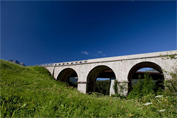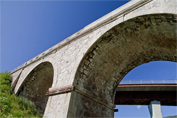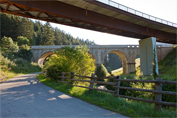thema! Historische Rasner Brücke Traditional Geocache
thema! Historische Rasner Brücke
-
Difficulty:
-

-
Terrain:
-

Size:  (small)
(small)
Related Web Page
Please note Use of geocaching.com services is subject to the terms and conditions
in our disclaimer.
 |
|
- - - DEUTSCH |
|
Hier, am Rande des archäologischen Gebiets „Windschnur“, treffen drei herausragende Zeitzeugnisse des Straßen- und Brückenbaues im Pustertal aufeinander:
 |
- Die Steinbogenbrücke, erbaut 1847 im Zug des Ausbaues der Pustertaler Straße unter Kaiser Ferdinand I. Sie trug bis 2008 den gesamten Verkehr durch das Pustertal.
- Die Stahl- und Betonbrücke, erbaut von der Autonomen Provinz Bozen und 2008 in Betrieb gesetzt. Die neue Brücke ist Teil des umfangreichen Ausbauprogramms an der Pustertaler Straße.
- Die Holzbrücke tiefer unten. Über sie führte die alte, bis 1847 befahrene Pustertaler Poststraße. Heute überquert hier eine Feldwegbrücke den Antholzer Bach.
|
Der Bau der neuen Brücke über den Antholzer Bach machte es möglich, die bauhistorisch wertvolle Steinbrücke zu restaurieren und als Dokument neuzeitlicher Straßenbaukunst zu erhalten. In drei Abschnitten sind hier drei Epochen Pustertaler Straßen- und Brücken-Geschichte dokumentiert.
 |
- Der hintere, östliche Teil der Brücke ist im Bauzustand belassen, so wie er bis 2008 diente: mit Asphaltbelag und Stahlleitplanken.
- Der mittlere Abschnitt belegt den Straßenzustand nach dem Ausbau von 1938: mit erstem Asphaltbelag und Brüstungselementen aus Betonfertigteilen.
- Der vordere Abschnitt wurde in den historischen Zustand von 1847 zurückgeführt. Auf der Grundlage der Originalpläne mit festem Kalkschotterbelag, steinernen Brüstungsmauern sowie Geländern mit Granitwehrsteinen und Holzbalken.
|
|
 |
|
- - - ENGLISH |
|
Here, at the border of the archeologically important "Windschnur" area, three extra-ordinary testimonies of the road and bridge constructions in the Pustertal are meeting:
 |
- the stone arch bridge, built in 1847 during the extension of the Pustertal road under Emperor Ferdinand I. Until 2008 it carried the whole traffic through the Pustertal.
- The steel- and concrete-bridge, built in 2008 by the Autonomous Province of Bozen. The new bridge is part of the substantial extension program of the Pustertal road.
- The timber bridge. It was part of the old post road through the Pustertal that was in use until 1847.
|
The construction of the new bridge across the Antholz stream made it possible to restore the historically valuable stone bridge and to keep it as a testimony of the modern art of road building. The following three subparts document three historical epochs of the Pustertal road- and bridge-construction.
 |
- The backmost, eastern part of the bridge has been left in the conditions it was since 2008: with asphalt covering and crash barriers out of steel.
- The middle part shows the road after its extension in 1938: with the first asphalt covering and hand rails out of concrete.
- The anterior part was transformed into its original state in 1847: according to the original project plans with chalk ballast covering, hand rails out of stone as well as balustrades out of wood and granite.
|
|
 |
|
- - - ITALIANO |
|
Qui, al lato della zona archeologica "Windschnur" di Rasun, si incrociano tre testimonianze storiche della costruzione di strade e ponti in Val Pusteria:
 |
- il ponte ad arco in pietra eretto nel 1847 nell'ambito del recupero della strada da parte dell'imperatore Ferdinando I. Fino al 2008 vi scorreva l'intero transito di uomini e merci per la Pusteria.
- •Il ponte in cemento ed acciaio, costruito dalla Provincia Autonoma e aperto al traffico nel 2008. Il nuovo ponte fa parte del programma di rifacimento dell'intero tratto stradale.
- •Il ponticello di legno, situato più in basso. Su di esso passava, fino al 1847, la vecchia "strada postale" della Pusteria. Oggi vi passa solamente un sentiero, che attraversa il torrente di Anterselva.
|
La costruzione del nuovo ponte sul rio della Valle Anterselva ha reso possibile la restaurazione del vecchio ponte di pietra e la sua conservazione quale prezioso documento di ingegneria stradale contemporanea. In tre tratti sono documentate tre epoche storiche della strada della Pusteria.
 |
- Il tratto in fondo al ponte, verso est, è lasciato nelle condizioni in cui versava fino al 2008: con lo strato d'asfalto e il guard-rail in acciaio;
- il tratto di mezzo, mostra lo stato così come si presentava dopo l'intervento risanatorio del 1938: con il primo strato d'asfalto e la balaustra di elementi prefabbricati in calcestruzzo;
- il tratto iniziale fu riportato, sulla base dei progetti originali, allo stato storico del 1847: con lo strato di ghiaia calcarea, muri di balaustra in pietra, paracarri in granito e travi in legno.
|
|
*****
Inhalt / content / contenuto:
FTF certificate
pencil, sharpener, logbook
Flaschenverschluss
kleine LED-Lampe
Kajalstift
Steinchen
Teelicht
Duschgel
Münze
Figur
Additional Hints
(Decrypt)
Fgrvaznhre qverxg uvagre qrz Zrvyrafgrva / zheb qv cvrgen nccran byger yn cvrgen zvyvner / fgbar jnyy whfg cnfg gur zvyrfgbar